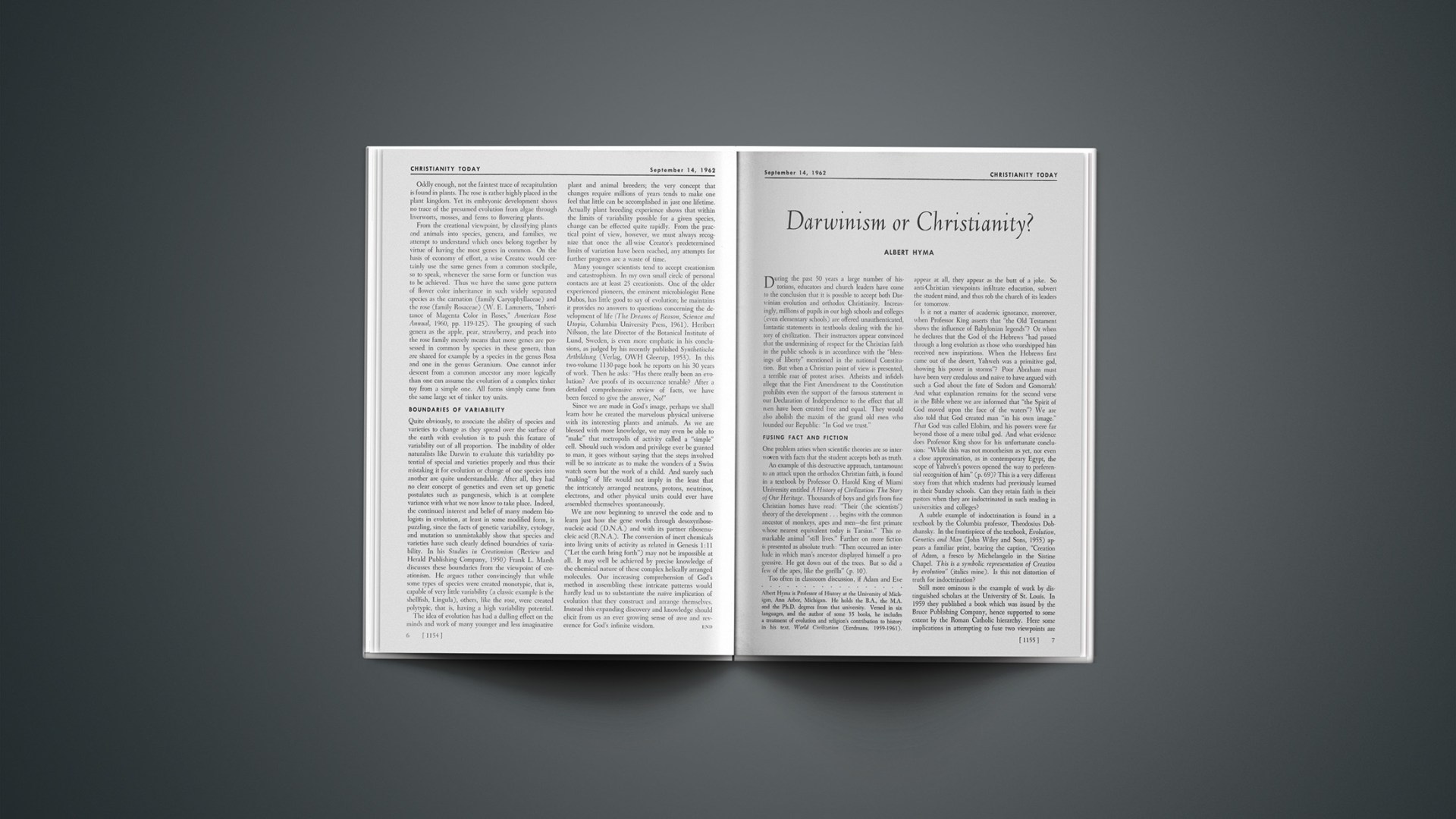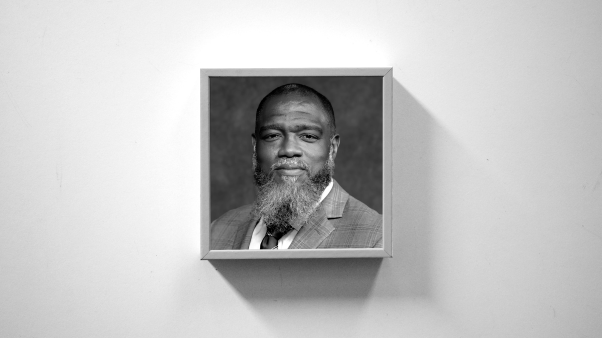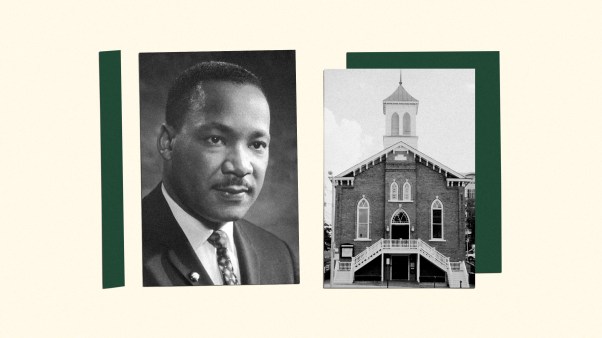During the past 50 years a large number of historians, educators and church leaders have come to the conclusion that it is possible to accept both Darwinian evolution and orthodox Christianity. Increasingly, millions of pupils in our high schools and colleges (even elementary schools) are offered unauthenticated, fantastic statements in textbooks dealing with the history of civilization. Their instructors appear convinced that the undermining of respect for the Christian faith in the public schools is in accordance with the “blessings of liberty” mentioned in the national Constitution. But when a Christian point of view is presented, a terrible roar of protest arises. Atheists and infidels allege that the First Amendment to the Constitution prohibits even the support of the famous statement in our Declaration of Independence to the effect that all men have been created free and equal. They would also abolish the maxim of the grand old men who founded our Republic: “In God we trust.”
Fusing Fact And Fiction
One problem arises when scientific theories are so interwoven with facts that the student accepts both as truth.
An example of this destructive approach, tantamount to an attack upon the orthodox Christian faith, is found in a textbook by Professor O. Harold King of Miami University entitled A History of Civilization: The Story of Our Heritage. Thousands of boys and girls from fine Christian homes have read: “Their (the scientists’) theory of the development … begins with the common ancestor of monkeys, apes and men—the first primate whose nearest equivalent today is Tarsius.” This remarkable animal “still lives.” Farther on more fiction is presented as absolute truth: “Then occurred an interlude in which man’s ancestor displayed himself a progressive. He got down out of the trees. But so did a few of the apes, like the gorilla” (p. 10).
Too often in classroom discussion, if Adam and Eve appear at all, they appear as the butt of a joke. So anti-Christian viewpoints infiltrate education, subvert the student mind, and thus rob the church of its leaders for tomorrow.
Is it not a matter of academic ignorance, moreover, when Professor King asserts that “the Old Testament shows the influence of Babylonian legends”? Or when he declares that the God of the Hebrews “had passed through a long evolution as those who worshipped him received new inspirations. When the Hebrews first came out of the desert, Yahweh was a primitive god, showing his power in storms”? Poor Abraham must have been very credulous and naїve to have argued with such a God about the fate of Sodom and Gomorrah! And what explanation remains for the second verse in the Bible where we are informed that “the Spirit of God moved upon the face of the waters”? We are also told that God created man “in his own image.” That God was called Elohim, and his powers were far beyond those of a mere tribal god. And what evidence does Professor King show for his unfortunate conclusion: “While this was not monotheism as yet, nor even a close approximation, as in contemporary Egypt, the scope of Yahweh’s powers opened the way to preferential recognition of him” (p. 69)? This is a very different story from that which students had previously learned in their Sunday schools. Can they retain faith in their pastors when they are indoctrinated in such reading in universities and colleges?
A subtle example of indoctrination is found in a textbook by the Columbia professor, Theodosius Dobzhansky. In the frontispiece of the textbook, Evolution, Genetics and Man (John Wiley and Sons, 1955) appears a familiar print, bearing the caption, “Creation of Adam, a fresco by Michelangelo in the Sistine Chapel. This is a symbolic representation of Creation by evolution” (italics mine). Is this not distortion of truth for indoctrination?
Still more ominous is the example of work by distinguished scholars at the University of St. Louis. In 1959 they published a book which was issued by the Bruce Publishing Company, hence supported to some extent by the Roman Catholic hierarchy. Here some implications in attempting to fuse two viewpoints are clearly seen: others are not. The authors proclaim that the account in Genesis is not reliable. They dare not offend the great scientists who thunder forth their anathemas against the humble Christian’s belief in the fall of man or the operation of Satan among men. They imply that God did not say to Satan: “And I will put enmity between thee and the woman, and between thy seed and her seed; it shall bruise thy head, and thou shalt bruise his heel.” Modern science is supposed to have proved that the very first human beings were very different from the two named in the Bible.
Now let us examine the exact phraseology used by the three historians at the University of St. Louis (Thomas P. Neill, Daniel D. McGarry, and Clarence L. Hohl). In A History of Western Civilization they reiterate: “According to modern scientists, man is not descended from the apes as we know them, but man and present-day apes derive from a common previous ancestor, now extinct” (Vol. I, p. 12). Then they offer the amazing opinion that this theory of evolution implies nothing “for our beliefs in God, creation, a human spiritual soul, immortality, and moral responsibility as formulated by theistic philosophy, revealed religion and the Bible.” No matter how the human body originated, “the dependence of man and nature upon God is unassailed.” And as for the development of religious concepts, we meet again the idea that man advanced from barbarism to civilization. We are informed that “in this process, man seemed to pass from a vague monotheism through polytheism and back again to monotheism” (p. 21). The textbook in question does not bear the official approval of any archbishop in the Roman Catholic Church; had such been granted, the archbishop would have repudiated the faith of his own communion.
So, a compromise has been attempted between two bitter enemies—Darwinian evolution and orthodox Christianity.
The Biblical View
The Bible does not teach that man descended from animals and rose from barbarism to civilization; on the contrary, it teaches that Adam and Eve were created in God’s image and endowed with immense spiritual talents. These were largely ruined, as both Martin Luther and Ignatius Loyola taught, by disobedience to the commandment of God not to eat of the fruit produced by the tree of the knowledge of good and evil.
As soon as our young people have been convinced through their textbooks dealing with the history of civilization that there never was such a thing as original sin, they must conclude that the human race does not need a Saviour and that the sacraments of baptism and communion are superfluous, for there is no such thing as present sin. If true, the Mass then loses its value for the Roman Catholic Church. The whole hierarchy of that communion would, in time, find itself without clientele. And Protestants would have to abolish the Sunday school.
‘It Doth Not Yet Appear’
Not yet on winter’s
Brittle branches bare
Can we perceive
What will be clothed
In vibrant green.
Not yet in single kerneled corn
Can we behold the tasseled ear,
Not in the dearest human form
See with the certainty of sight
The immortality
That we shall one day wear.
Yet we may glory in the glance
All darkly seen
Of naked branches
Dressed in spring’s new green;
Of one bare grain
Miraculously multiplied;
Of human dust in death
Whose spectral seeming end
By spirit is denied.
RUTHE T. SPINNANGER
Difficulties With Evolution
In the acceptance of evolutionary theory honest differences of findings are too seldom discussed. Paleontological evidence is the basis for evolution: yet there are limits to paleontological evidence, as some scientists state, and unresolved problems in relation to it. Why is this not more frequently mentioned?
Suppose human beings do owe their existence to animals who produced them. How did that sort of production cease? How prevent a reversal from human to animal life? Does any leading scientist today imagine that—with or without a god—the process of evolution would come to a halt? Then why do dogs reproduce dogs and why do monkeys also remain true to their own kind? No anthropologist has ever demonstrated from any findings that the origin of species as envisioned by Charles Darwin was “nothing but the truth.” It actually is still pure fiction. Why are its implications taught as truth?
In Genesis 1:25 we are told that “God made the beast of the earth after his kind, and cattle after their kind, and everything that creepeth upon the earth after his kind: and God saw that it was good.” Each group reproduced after its kind: one group did not produce another kind. Moreover, man and animals were sharply differentiated, for in the next verse we read: “And God said, Let us make man in our image, after our likeness: and let them have dominion over the fish of the sea,” and so forth. In the Hebrew original the word for God is Elohim, which at first had a double meaning. For this reason we have the plural pronoun and verb: “Let us make man in our image, after our likeness.” Here again we have the significant phrases: “after our likeness” and “after their kind.” Man was made after the likeness of God.
As long as secular historians who do not believe in the Bible ignore its teachings, it is possible to argue that they present a view contrary to that of orthodox Christians. But when professors state that their view is the same as that expressed in the Bible while they are denying the veracity of the Book of Genesis, they are causing immense confusion. Worse than that, they are misleading their own students. Instead of combining two points of view that are diametrically opposed, they assist secular scholars by making it appear as if the Bible actually supports Darwinian evolution.
Biblical teachings involved go far beyond the Genesis account. The Apostle Paul said in 1 Corinthians 15:45: “And so it is written, The first man Adam was made a living soul; the last Adam was made a quickening spirit.” He assumed that human beings (with no mention of animals) could participate in the resurrection. The natural body of man is “sown in corruption; it is raised in incorruption.” In verse 39 he remarked that “there is one kind of flesh of men, another flesh of beasts.” He had in mind the enormous difference between animals and human beings. He would have gasped with astonishment to hear that monkeys were closely related to human beings. (To call some of them apes would have made little difference!) No animals were assured a resurrection, no animals were made in the image of God.
Vanishing Fear Of Sin
A major unfortunate result of teaching evolutionary theory as truth has been the loss of fear for commission of sins. Men will argue that the word “sins” is now out of date. Errors are conceded, to be sure, but it is no longer fashionable to speak of sin and sinners. As human beings rise to ever greater heights of wisdom, they care less and less about the “inevitable punishment” that follows crime. They now can make their own laws and feel that somehow they can escape the results of evil actions and thoughts. Both heaven and hell fade away from the scene of scientific research. The things unseen by human eyes lose their significance. Conscience has importance only as a rudimentary survival (its presence at all being unexplained mystery) and moral law is based solely upon mores. Thus all values become relative and transitory. In short, Darwinian evolution and Christianity are enemies, not friends.
Illuminating, as a contrast, is a statement made in the Third Number of the Baltimore Catechism, published in 1933. In explanation of Question 63 the author presents the official teaching of the Roman Catholic Church: “The creation of Eve, the wife of Adam, shows that the whole human race descends from one man.… Evolution is the theory that man developed from lower forms of animals. There is no scientific proof for evolution, though it claims to be scientific.” We are also informed here that if evolution were true, “it ought to be able to repeat itself.” Inferior skulls might well be “cases of degeneracy and prove nothing.”
How well Professor Martin Luther in his lectures on Paul’s Epistle to the Romans, delivered in the academic year 1515–1516, understood the facts of life. He stated: “What is original sin? It is the loss of all rectitude and all efficiency in all our faculties, both of the body and the soul.” Luther referred to a famous book by Gerard Zerbolt of Zutphen, entitled Spiritual Ascensions, in which he found original sin described in a manner unsurpassed outside of the Bible. Zerbolt had drawn the following conclusion: “We have been contaminated by original sin, and wounded in all the powers and faculties of the soul.… Christ through his precious death does indeed redeem us from our original sin.” All the great creeds of Christendom have supported these views. Unfortunately, the sermons preached on Sunday are disregarded by students who have been indoctrinated by their textbooks to opposing pronouncements. If they think that there is no need of a choice, they simply do not understand the present contest between Christ and Satan.
If it is a violation of the First Amendment to teach the biblical story of creation in our schools, it is also a violation of religious freedom to teach a conflicting theory of origins as truth.










